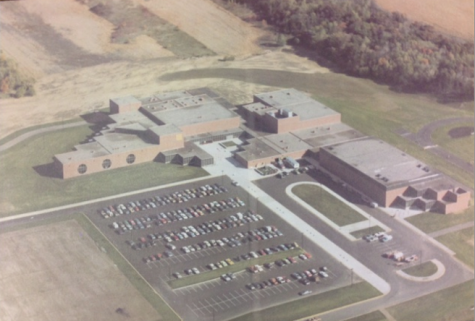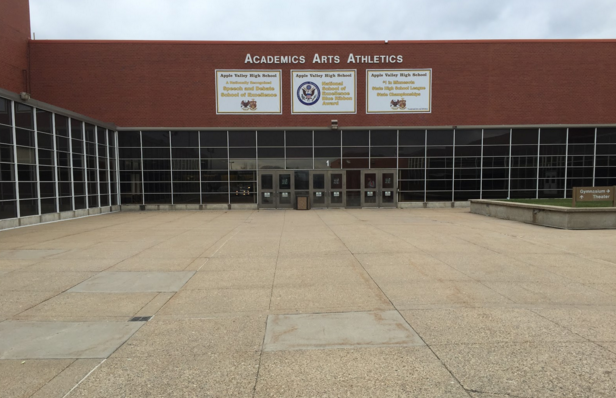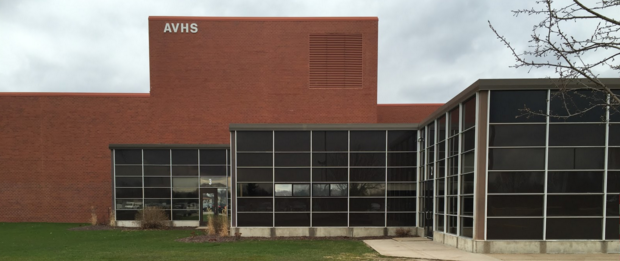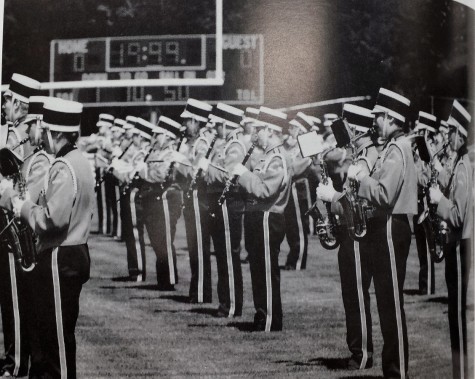AVHS: Building on Tradition
In the fall of 1976, a new era emerged with the opening of Apple Valley High School. Students from the surrounding area began to roam the hallways, meet life-long friends and learn what it truly means to be an Eagle. Although these students did not know this at the time, they were walking the halls of a school that became known for its revolutionary design.
In 1970, the Comprehensive Planning Committee of the Village of Apple Valley set out to plan the growth of the area. While outlining plans for businesses and community facilities, the committee proposed a high school located on the same street as Westview Elementary School in 1972. Although AVHS was eventually built on Hayes Road, the committee was successful in recognizing the need for a high school in Apple Valley.
The groundbreaking of AVHS was truly groundbreaking in nature. Becoming just the second high school in District 196, the design and layout of Apple Valley High School soon set the standard for practical and innovative learning environments.

Apple Valley High School in 1976, when it first opened.
At a time when most schools had closed and confined classrooms, Apple Valley embodied an open concept that was unheard of for high schools. Although Greenleaf Elementary had just enacted a semi-open concept two years prior, AVHS took a different approach with a full open design, implemented to allow for optimum flexibility and collaboration.
In “The History of a School District” by JoAnn Friberg, former Assistant Superintendent of Schools Dr. Lee Droegmueller is quoted saying, “In an open school building everyone can see each other; it creates an atmosphere of awareness of the world around you which leads to a better relationship with your fellow man.”
Apple Valley purposefully created the atmosphere Droegmueller alluded to with the placement of the library in the middle of the school. This allowed for it to be an open resource for all students throughout the school day.
“The whole concept of Apple Valley was revolutionary when it opened,” said former assistant principal Nancy Grimes when asked about the library’s placement. The classrooms surrounding the library had no fourth wall, allowing the library to be an area for teachers and students to work both formally and informally. This was something not readily seen in high schools; most libraries at the time were closed off, greatly reducing the opportunities for students.

Apple Valley’s library is located in the center of the school embodying the open concept.
Today, AVHS is taking more steps to continue this unique trend in the library. With the addition of wheeled tables in the library pit, students have more opportunity to work in groups, adding to their flexibility and creativity. Not only do these tables promote group work, they promote the same open and accessible feel that the library was originally intended to instill.
The design is ever so slowly adapting to a more “mobile and flexible model,” notes media specialist Mr. McCluskey. This helps to promote collaboration and is more similar to what a college campus looks like.
The open concept was also employed with the teachers’ desks being located in the student hallways. This allowed for students to have immediate access to teachers both before and after school. When designing the school, the designers envisioned an atmosphere that students would feel comfortable with. Having teachers’ desks in the hallway gave students an insight to the teachers’ identities through interactions usually not seen in closed offices. This also eliminated the often intimidating process of entering a teacher’s office.

Due to these stronger relationships between students and teachers, the desks remain in the hallways today. “The desks give perspective of other teachers and students based on how we see them in the hallway,” said language arts teacher Ms. Rief-Gregory when asked about the benefit to AVHS.
Assistant Principal Michael Bolsoni echoed that sentiment: “The teachers’ desks reduce barriers between students and staff.”
Although having the desks in the halls may seem distracting, the cooperation and cohesiveness that result is something that is not seen in other high schools with traditional teacher offices.

Teachers in the math department all have desks in the same area to allow for easy collaboration.
To add to the benefits of this open concept, a bright and engaging color scheme was incorporated throughout the school. Bright orange and green colors were painted throughout the school with the decor matching this scheme.
Ms. Rief-Gregory noted that these were intended to increase energy and keep the students’ brains flowing.
Although the initial reasoning behind the bright colors is understandable, many teachers–including Ms. Rief-Gregory–were happy to see the orange carpeting go.
As we look forward to the years ahead, there is even more talk about enhancing the architecture of our school. The major change: the front entrance.
When the school first opened, people walked directly into the attendance office. Now, after 40 years and multiple redesigns, that area has become the main office/guidance counselor area; the attendance office took over classroom space down the hall. Before, people were funneled through the office when they arrived at AVHS. A much safer means, because everyone that comes in is then forced to check-in, whereas now you can find straggling seniors walking in late in the morning and bypassing the attendance office altogether.

Current entrance to AVHS.
Instead of this, the school plans on removing the front courtyard and extending the building to where the flagpole resides currently. This would increase space for either classrooms, or a study area, and funnel people right into the attendance office.
Based on a poll supplied by The Talon back in December, most people (42 percent) want a school cafe and–coming in a close second (31 percent)–study areas.
Either way, this new face lift will modernize Apple Valley High School even further.
As for the insides, this bond money will hopefully be spent on purchasing some new furniture. Now some may love the sled desks, but most realize how limiting they really are.
Not only do they stall collaboration, but they are original to the school. Admittedly, part of that is cool. Sitting in math class you can ask yourself if you are sitting in the same desk that Arden Cho or Tyus Jones sat in to learn. But, as body types and teaching styles continue to change over the years, the sled desks are becoming more and more confined.
With the new bond money, plans are in the works for purchasing more advanced seating: swivel desks. These chairs can already be found in a few classrooms scattered across different subject areas in AVHS, ranging from English to Math to Japanese. Since they are on wheels, and do in fact swivel, students are able to easily move around and redesign the layout of the room in less than a minute.

Senior Kayla Kirtz and classmates work on their research papers in the new swivel desks.
“The swivel desks allow for easier communication and more effective group work; you just can’t move around in the sled desks and that is really limiting in the classroom,” says senior Kayla Kirtz.
The school may also buy new teachers desks, because, after 40 years, very few of them have been replaced.
Looking back on your high school years, what is mostly remembered are your friends, teachers and classes, but what is often ignored is the building itself. Apple Valley High School created a learning environment that was revolutionary at the time, and will continue to set the standard for generations to come.








Patrick J Wiles • Mar 5, 2017 at 4:00 pm
I graduate in 1980 from AVHS. There are desks there? All we had were tables that we shared with one another.
Mary Schroeder Overstreet • Mar 4, 2017 at 6:26 pm
I’m from the class of ’84 but my stepsister, Terry McCarty was in the first class to graduate from AVHS. I loved that school and felt perfectly at home with the open concept having come from Valley Middle School. I truly hated having to leave just prior to the start of my senior year as a result of my family moving out of state.
Jessie Mader • Mar 4, 2017 at 3:35 pm
As a graduate of 1994 I remember when eating in where the cafeteria and going up and down the stairs to get to your next class and the lockers next to the gym. Also my favorite time was planning in the band concert as well as watching apart of the plays.
Bill Ryan • Mar 3, 2017 at 3:42 pm
It was truly wonderful going to AVHS. The student staffed radio station, theater, and sports facilities were also second to none at the time in the mid 80’s. The gymnasium and the arena with with the orange and green paint designs on the walls and ventilation system truly kept you alert.
This has been, Bill Ryan of KXAV’s “Alacarte Hour” signing off!
’86
Dustin Sawrey • Mar 5, 2017 at 8:52 am
Who was the big Elvis Costello fan at KXAV circus 1983-1984? It seems like they played “Every Day I Write The Book” every morning! Good times!!
Scott Rowe • Apr 11, 2016 at 2:23 pm
I remember the orange and green walls and carpet, peas and carrots. Are the blues chairs still there?
Claire Hoffa • Apr 11, 2016 at 7:19 pm
Thanks for commenting, like us on facebook or twitter for more stories like this one! As for the chairs, there aren’t any blue chairs in the entry way anymore, but we do have blue chairs in the media center now!
Donna Lock • Apr 10, 2016 at 11:03 pm
I love the new looks with colored chairs and the new swivel desks. The idea of rolling tables in the pit is wonderful. I will be interested to see the new entrance; I think it is a terrific idea. I miss you all!!!